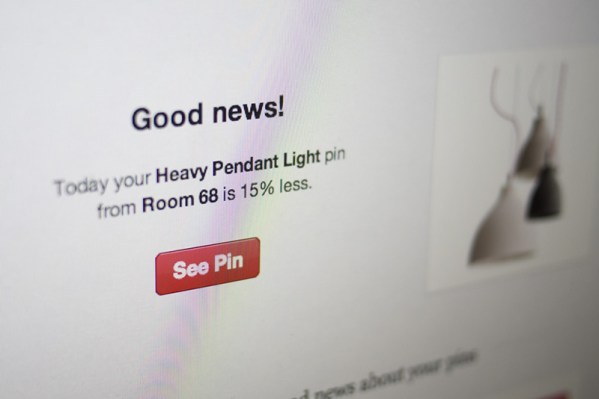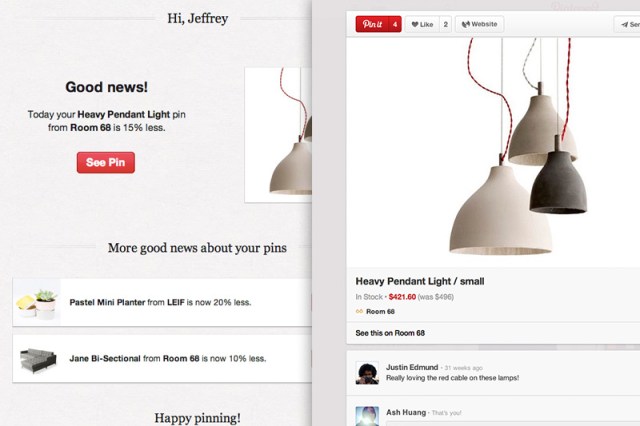Pinterest, which has long since served as a place where users collect items they want to buy as well as a leading referral source for e-commerce websites, is today taking another step toward encouraging users to not just aspire, but actually purchase the items they save with the debut of price alerts. The company explains that it’s now iterating on its previously released “pin price” feature, which allowed users to see the current price of product pins on the site.
With the introduction of price alerts, Pinterest now actually monitors those pin prices for changes, too.
To use price alerting, you simply save a product pin to one of your boards, and if the price ever drops, you’re alerted via an email notification. A company representative explains to us that Pinterest will try to aggregate those notifications into as few emails as possible, in order to not overload users’ email inboxes. The frequency of these emails can also be controlled in users’ settings.
In addition to email alerts, pinned products on the site can also showcase the price change, indicating that the current price listed is a drop from an earlier, higher one.
You may recall that Pinterest this May had introduced new pin types, including product pins (for example, these) along with others like recipe pins and movie pins. These enhanced pins show you more information than the usual pin, and in the case of products like clothing, accessories, furniture or anything else you want to purchase, the pin includes the current price of the item, the retailer’s logo, and a link to the e-commerce website where the product can be purchased.
Online merchants can “enhance” their pins, product or otherwise, by placing additional code on their websites to help Pinterest identify and validate the pins. Many well-known retailers now do this, including big names like Walmart, Target, Neiman Marcus, Sephora, Nordstrom, and Home Depot, for instance, as well as online shops and marketplaces like ModCloth, Etsy, eBay, ASOS, Zulily, Urban Outfitters, and Free People, to name a few.
Pinterest says that today, there are tens of millions of product pins on its site, and early results show that these are generating higher click-through rates to the e-commerce sites versus regular pins.
This week, the company had said that this year’s focus is on bringing more value to the pins that users are saving on the site. Already, it’s doing this not only with richer pins, but also tools for businesses, including improved Pin It buttons, which now work in mobile apps, widget builders and even analytics.
With the debut of price alerting, the company is challenging several startups that help consumers figure out when it is the right time to buy. Some of those are Decide.com, whose focus is more on consumer electronics and larger purchases for the home, plus recently launched Nifti, and even a Pinterest for price drops, Clipix, as well as a slew of older tools for price alerting and tracking sales.
More generally, though, this also puts Pinterest up against other social product aggregators like Fancy or Wanelo, the former having always been more of an actionable, shoppable feed of products, while the other is more focused on making it easier to find what’s popular at your favorite stores.
Like other features Pinterest recently introduced, such as the newly added personalization options in the form of pin and board suggestions, price alerting is rolling out slowly to users starting now, so you may not see the option available immediately.

